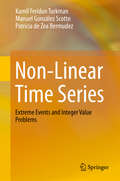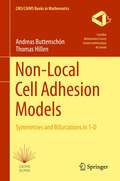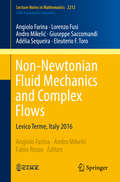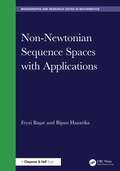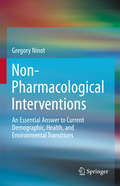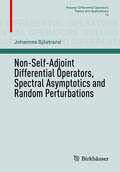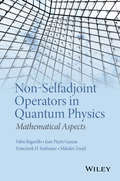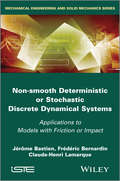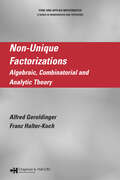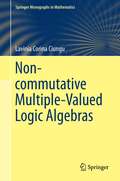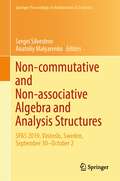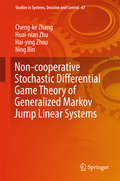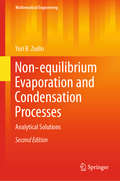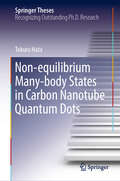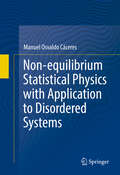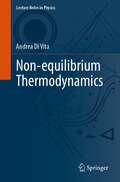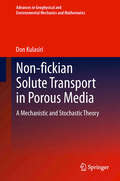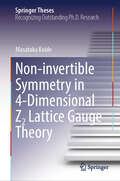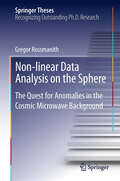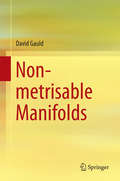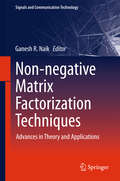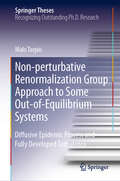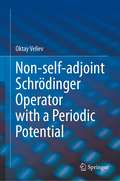- Table View
- List View
Non-Linear Time Series
by Kamil Feridun Turkman Manuel González Scotto Patrícia Zea BermudezThis book offers a useful combination of probabilistic and statistical tools for analyzing nonlinear time series. Key features of the book include a study of the extremal behavior of nonlinear time series and a comprehensive list of nonlinear models that address different aspects of nonlinearity. Several inferential methods, including quasi likelihood methods, sequential Markov Chain Monte Carlo Methods and particle filters, are also included so as to provide an overall view of the available tools for parameter estimation for nonlinear models. A chapter on integer time series models based on several thinning operations, which brings together all recent advances made in this area, is also included. Readers should have attended a prior course on linear time series, and a good grasp of simulation-based inferential methods is recommended. This book offers a valuable resource for second-year graduate students and researchers in statistics and other scientific areas who need a basic understanding of nonlinear time series.
Non-Local Cell Adhesion Models: Symmetries and Bifurcations in 1-D (CMS/CAIMS Books in Mathematics #1)
by Thomas Hillen Andreas ButtenschönThis monograph considers the mathematical modeling of cellular adhesion, a key interaction force in cell biology. While deeply grounded in the biological application of cell adhesion and tissue formation, this monograph focuses on the mathematical analysis of non-local adhesion models. The novel aspect is the non-local term (an integral operator), which accounts for forces generated by long ranged cell interactions. The analysis of non-local models has started only recently, and it has become a vibrant area of applied mathematics. This monograph contributes a systematic analysis of steady states and their bifurcation structure, combining global bifurcation results pioneered by Rabinowitz, equivariant bifurcation theory, and the symmetries of the non-local term. These methods allow readers to analyze and understand cell adhesion on a deep level.
Non-Newtonian Fluid Mechanics and Complex Flows: Levico Terme, Italy 2016 (Lecture Notes in Mathematics #2212)
by Adélia Sequeira Angiolo Farina Andro Mikelić Giuseppe Saccomandi Fabio Rosso Eleuterio F. ToroThis book presents a series of challenging mathematical problems which arise in the modeling of Non-Newtonian fluid dynamics. It focuses in particular on the mathematical and physical modeling of a variety of contemporary problems, and provides some results. The flow properties of Non-Newtonian fluids differ in many ways from those of Newtonian fluids. Many biological fluids (blood, for instance) exhibit a non-Newtonian behavior, as do many naturally occurring or technologically relevant fluids such as molten polymers, oil, mud, lava, salt solutions, paint, and so on. The term "complex flows" usually refers to those fluids presenting an "internal structure" (fluid mixtures, solutions, multiphase flows, and so on). Modern research on complex flows has increased considerably in recent years due to the many biological and industrial applications.
Non-Newtonian Sequence Spaces with Applications (Chapman & Hall/CRC Monographs and Research Notes in Mathematics)
by Feyzi Başar Bipan HazarikaNon-Newtonian Sequence Spaces with Applications presents an alternative to the usual calculus based on multiplication instead of addition. The book is intended for graduate students and researchers with a special interest in non-Newtonian calculus, its applications and related topics.Features· Valuable material for postgraduate researchers studying non-Newtonian calculus· Suitable as supplementary reading to a Computational Physics course
Non-Pharmacological Interventions: An Essential Answer to Current Demographic, Health, and Environmental Transitions
by Gregory NinotNon-pharmacological interventions (NPIs) have become essential solutions for better living, preventing disease, and self-care, in addition to biomedical treatments, and for increasing longevity without loss of quality of life. Over the past 20 years, these practices have gone from general diet and hygiene advice to targeted and personalized solutions for prevention, care optimization, and curative treatments. Selected empirically for centuries or recently with the help of technological innovations and epigenetic, interventional, and medico-economic studies, their development is growing and diversifying around the world. Today an NPI ecosystem is made up of a myriad of public and private actors. As interest in NPIs grows, so do questions about safety, effectiveness, standardization, ethical practice, and surveillance. In this book, the author answers these questions with a scientific approach, because evidence-based science, evidence-based practice, clinical research, and data monitoring have revolutionized this field. Topics explored among the chapters include: · Defining Non-Pharmacological Interventions · The Benefits and Dangers of Non-Pharmacological Interventions · Motives and Facilitators of Non-Pharmacological Intervention Use · The Market for Non-Pharmacological Interventions · Evaluation of Non-Pharmacological Interventions · The Future of Non-Pharmacological Interventions Non-Pharmacological Interventions: An Essential Answer to Current Demographic, Health, and Environmental Transitions is a must-have resource for clinicians and other health professionals, researchers, students, health insurers, policy-makers, caregivers, and entrepreneurs in the health and wellness space, as well as any users who wish to inform themselves about NPIs.
Non-Riemannian Geometry (Dover Books on Mathematics #8)
by Luther Pfahler EisenhartNon-Riemannian Geometry deals basically with manifolds dominated by the geometry of paths developed by the author, Luther Pfahler Eisenhart, and Oswald Veblen, who were faculty colleagues at Princeton University during the early twentieth century. Eisenhart played an active role in developing Princeton's preeminence among the world's centers for mathematical study, and he is equally renowned for his achievements as a researcher and an educator.In Riemannian geometry, parallelism is determined geometrically by this property: along a geodesic, vectors are parallel if they make the same angle with the tangents. In non-Riemannian geometry, the Levi-Civita parallelism imposed a priori is replaced by a determination by arbitrary functions (affine connections). In this volume, Eisenhart investigates the main consequences of the deviation.Starting with a consideration of asymmetric connections, the author proceeds to a contrasting survey of symmetric connections. Discussions of the projective geometry of paths follow, and the final chapter explores the geometry of sub-spaces.
Non-Self-Adjoint Differential Operators, Spectral Asymptotics and Random Perturbations (Pseudo-Differential Operators #14)
by Johannes SjöstrandThe asymptotic distribution of eigenvalues of self-adjoint differential operators in the high-energy limit, or the semi-classical limit, is a classical subject going back to H. Weyl of more than a century ago.In the last decades there has been a renewed interest in non-self-adjoint differential operators which have many subtle properties such as instability under small perturbations. Quite remarkably, when adding small random perturbations to such operators, the eigenvalues tend to distribute according to Weyl's law (quite differently from the distribution for the unperturbed operators in analytic cases). A first result in this direction was obtained by M. Hager in her thesis of 2005. Since then, further general results have been obtained, which are the main subject of the present book.Additional themes from the theory of non-self-adjoint operators are also treated. The methods are very much based on microlocal analysis and especially on pseudodifferential operators. The reader will find a broad field with plenty of open problems.
Non-Selfadjoint Operators in Quantum Physics
by Franciszek Hugon Szafraniec Fabio Bagarello Jean-Pierre Gazeau Miloslav ZnojilA unique discussion of mathematical methods with applications to quantum mechanics Non-Selfadjoint Operators in Quantum Physics: Mathematical Aspects presents various mathematical constructions influenced by quantum mechanics and emphasizes the spectral theory of non-adjoint operators. Featuring coverage of functional analysis and algebraic methods in contemporary quantum physics, the book discusses the recent emergence of unboundedness of metric operators, which is a serious issue in the study of parity-time-symmetric quantum mechanics. The book also answers mathematical questions that are currently the subject of rigorous analysis with potentially significant physical consequences. In addition to prompting a discussion on the role of mathematical methods in the contemporary development of quantum physics, the book features: Chapter contributions written by well-known mathematical physicists who clarify numerous misunderstandings and misnomers while shedding light on new approaches in this growing area An overview of recent inventions and advances in understanding functional analytic and algebraic methods for non-selfadjoint operators as well as the use of Krein space theory and perturbation theory Rigorous support of the progress in theoretical physics of non-Hermitian systems in addition to mathematically justified applications in various domains of physics such as nuclear and particle physics and condensed matter physics An ideal reference, Non-Selfadjoint Operators in Quantum Physics: Mathematical Aspects is useful for researchers, professionals, and academics in applied mathematics and theoretical and/or applied physics who would like to expand their knowledge of classical applications of quantum tools to address problems in their research. Also a useful resource for recent and related trends, the book is appropriate as a graduate-level and/or PhD-level text for courses on quantum mechanics and mathematical models in physics.
Non-Smooth Deterministic or Stochastic Discrete Dynamical Systems: Applications to Models with Friction or Impact
by Frederic Bernardin Claude-Henri Lamarque Jerome BastienThis book contains theoretical and application-oriented methods to treat models of dynamical systems involving non-smooth nonlinearities. The theoretical approach that has been retained and underlined in this work is associated with differential inclusions of mainly finite dimensional dynamical systems and the introduction of maximal monotone operators (graphs) in order to describe models of impact or friction. The authors of this book master the mathematical, numerical and modeling tools in a particular way so that they can propose all aspects of the approach, in both a deterministic and stochastic context, in order to describe real stresses exerted on physical systems. Such tools are very powerful for providing reference numerical approximations of the models. Such an approach is still not very popular nevertheless, even though it could be very useful for many models of numerous fields (e.g. mechanics, vibrations, etc.). This book is especially suited for people both in research and industry interested in the modeling and numerical simulation of discrete mechanical systems with friction or impact phenomena occurring in the presence of classical (linear elastic) or non-classical constitutive laws (delay, memory effects, etc.). It aims to close the gap between highly specialized mathematical literature and engineering applications, as well as to also give tools in the framework of non-smooth stochastic differential systems: thus, applications involving stochastic excitations (earthquakes, road surfaces, wind models etc.) are considered. Contents 1. Some Simple Examples. 2. Theoretical Deterministic Context. 3. Stochastic Theoretical Context. 4. Riemannian Theoretical Context. 5. Systems with Friction. 6. Impact Systems. 7. Applications–Extensions. About the Authors Jérôme Bastien is Assistant Professor at the University Lyon 1 (Centre de recherche et d'Innovation sur le sport) in France. Frédéric Bernardin is a Research Engineer at Département Laboratoire de Clermont-Ferrand (DLCF), Centre d'Etudes Techniques de l'Equipement (CETE), Lyon, France. Claude-Henri Lamarque is Head of Laboratoire Géomatériaux et Génie Civil (LGCB) and Professor at Ecole des Travaux Publics de l'Etat (ENTPE), Vaulx-en-Velin, France.
Non-Unique Factorizations: Algebraic, Combinatorial and Analytic Theory (Chapman & Hall/CRC Pure and Applied Mathematics)
by Alfred Geroldinger Franz Halter-KochFrom its origins in algebraic number theory, the theory of non-unique factorizations has emerged as an independent branch of algebra and number theory. Focused efforts over the past few decades have wrought a great number and variety of results. However, these remain dispersed throughout the vast literature. For the first time, Non-Unique Factoriza
Non-commutative Multiple-Valued Logic Algebras
by Lavinia Corina CiunguThis monograph provides a self-contained and easy-to-read introduction to non-commutative multiple-valued logic algebras; a subject which has attracted much interest in the past few years because of its impact on information science, artificial intelligence and other subjects. A study of the newest results in the field, the monograph includes treatment of pseudo-BCK algebras, pseudo-hoops, residuated lattices, bounded divisible residuated lattices, pseudo-MTL algebras, pseudo-BL algebras and pseudo-MV algebras. It provides a fresh perspective on new trends in logic and algebras in that algebraic structures can be developed into fuzzy logics which connect quantum mechanics, mathematical logic, probability theory, algebra and soft computing. Written in a clear, concise and direct manner, Non-Commutative Multiple-Valued Logic Algebras will be of interest to masters and PhD students, as well as researchers in mathematical logic and theoretical computer science.
Non-commutative and Non-associative Algebra and Analysis Structures: SPAS 2019, Västerås, Sweden, September 30–October 2 (Springer Proceedings in Mathematics & Statistics #426)
by Anatoliy Malyarenko Sergei SilvestrovThe goal of the 2019 conference on Stochastic Processes and Algebraic Structures held in SPAS2019, Västerås, Sweden, from September 30th to October 2nd 2019 was to showcase the frontiers of research in several important topics of mathematics, mathematical statistics, and its applications. The conference has been organized along the following tracks: 1. Stochastic processes and modern statistical methods in theory and practice, 2. Engineering Mathematics, 3. Algebraic Structures and applications. This book highlights the latest advances in algebraic structures and applications focused on mathematical notions, methods, structures, concepts, problems, algorithms, and computational methods for the natural sciences, engineering, and modern technology. In particular, the book features mathematical methods and models from non-commutative and non-associative algebras and rings associated to generalizations of differential calculus, quantum deformations of algebras, Lie algebras, Lie superalgebras, color Lie algebras, Hom-algebras and their n-ary generalizations, semi-groups and group algebras, non-commutative and non-associative algebras and computational algebra interplay with q-special functions and q-analysis, topology, dynamical systems, representation theory, operator theory and functional analysis, applications of algebraic structures in coding theory, information analysis, geometry and probability theory. The book gathers selected, high-quality contributed chapters from several large research communities working on modern algebraic structures and their applications. The chapters cover both theory and applications, and are illustrated with a wealth of ideas, theorems, notions, proofs, examples, open problems, and results on the interplay of algebraic structures with other parts of Mathematics. The applications help readers grasp the material, and encourage them to develop new mathematical methods and concepts in their future research. Presenting new methods and results, reviews of cutting-edge research, open problems, and directions for future research, will serve as a source of inspiration for a broad range of researchers and students.
Non-cooperative Stochastic Differential Game Theory of Generalized Markov Jump Linear Systems
by Cheng-Ke Zhang Huai-Nian Zhu Hai-Ying Zhou Ning BinThis book systematically studies the stochastic non-cooperative differential game theory of generalized linear Markov jump systems and its application in the field of finance and insurance. The book is an in-depth research book of the continuous time and discrete time linear quadratic stochastic differential game, in order to establish a relatively complete framework of dynamic non-cooperative differential game theory. It uses the method of dynamic programming principle and Riccati equation, and derives it into all kinds of existence conditions and calculating method of the equilibrium strategies of dynamic non-cooperative differential game. Based on the game theory method, this book studies the corresponding robust control problem, especially the existence condition and design method of the optimal robust control strategy. The book discusses the theoretical results and its applications in the risk control, option pricing, and the optimal investment problem in the field of finance and insurance, enriching the achievements of differential game research. This book can be used as a reference book for non-cooperative differential game study, for graduate students majored in economic management, science and engineering of institutions of higher learning.
Non-equilibrium Evaporation and Condensation Processes: Analytical Solutions (Mathematical Engineering)
by Yuri B. ZudinThis monograph is focused mostly on the exposition of analytical methods for the solution of problems of strong phase change. A new theoretical model is proved useful in describing, with acceptable accuracy, problems of strong evaporation and condensation. The book is the first to treat the problem of asymmetry for evaporation/condensation. A semi-empirical model for the process is proposed for purposes of practical calculation of the process of strong evaporation. The “limiting schemes” of the vapor bubble growth are analyzed. The thermo-hydrodynamic problem of evaporating meniscus of a thin liquid film on a heated surface is considered. A theoretical analysis of the problem of evaporation of a drop levitating over a vapor cushion is performed. The problem of vapor condensation upon a transversal flow around a horizontal cylinder is considered. The second edition is extended by (i) the conjugate “strong evaporation - heat conduction” problem, (ii) the influence of accommodation coefficients on intensive processes of evaporation and condensation, (iii) the problem of supersonic condensation. This book is the first to present a comprehensive theoretical approach of boiling problems: nucleate boiling, superfluid helium phase transition, similarity between pseudo-boiling and subcritical pressure nucleate boiling. The target audience primarily comprises research experts in the field of thermodynamics and fluid dynamics, but the book may also be beneficial for graduate students.
Non-equilibrium Many-body States in Carbon Nanotube Quantum Dots (Springer Theses)
by Tokuro HataThis book presents the first experiment revealing several unexplored non-equilibrium properties of quantum many-body states, and addresses the interplay between the Kondo effect and superconductivity by probing shot noise. In addition, it describes in detail nano-fabrication techniques for carbon nanotube quantum dots, and a measurement protocol and principle that probes both equilibrium and non-equilibrium quantum states of electrons. The book offers various reviews of topics in mesoscopic systems: shot noise measurement, carbon nanotube quantum dots, the Kondo effect in quantum dots, and quantum dots with superconducting leads, which are relevant to probing non-equilibrium physics. These reviews offer particularly valuable resources for readers interested in non-equilibrium physics in mesoscopic systems. Further, the cutting-edge experimental results presented will allow reader to catch up on a vital new trend in the field.
Non-equilibrium Statistical Physics with Application to Disordered Systems
by Manuel Osvaldo CáceresThis textbook is the result of the enhancement of several courses on non-equilibrium statistics, stochastic processes, stochastic differential equations, anomalous diffusion and disorder. The target audience includes students of physics, mathematics, biology, chemistry, and engineering at undergraduate and graduate level with a grasp of the basic elements of mathematics and physics of the fourth year of a typical undergraduate course. The little-known physical and mathematical concepts are described in sections and specific exercises throughout the text, as well as in appendices. Physical-mathematical motivation is the main driving force for the development of this text. It presents the academic topics of probability theory and stochastic processes as well as new educational aspects in the presentation of non-equilibrium statistical theory and stochastic differential equations.. In particular it discusses the problem of irreversibility in that context and the dynamics of Fokker-Planck. An introduction on fluctuations around metastable and unstable points are given. It also describes relaxation theory of non-stationary Markov periodic in time systems. The theory of finite and infinite transport in disordered networks, with a discussion of the issue of anomalous diffusion is introduced. Further, it provides the basis for establishing the relationship between quantum aspects of the theory of linear response and the calculation of diffusion coefficients in amorphous systems.
Non-equilibrium Thermodynamics (Lecture Notes in Physics #1007)
by Andrea Di VitaThe importance of thermodynamics, particularly its Second Principle, to all branches of science in which systems with very large numbers of particles are involved cannot be overstated. This book offers a panoramic view of non-equilibrium thermodynamics. Perhaps the two most attractive aspects of thermodynamic equilibrium are its stability and its independence from the specifics of the particular system involved. Does an equivalent exist for non-equilibrium thermodynamics? Many researchers have tried to describe such stability in the same way that the Second Principle describes the stability of thermodynamic equilibrium - and failed. Most of them invoked either entropy, or its production rate, or some modified version of it. In their efforts, however, those researchers have found a lot of useful stability criteria for far-from-equilibrium states. These criteria usually take the form of variational principles, in terms of the minimization or maximization of some quantity. The aim of this book is to discuss these variational principles by highlighting the role of macroscopic quantities. This book is aimed at a wider audience than those most often exposed to the criteria described, i.e., undergraduates in STEM, as well as the usual interested and invested professionals.
Non-fickian Solute Transport in Porous Media
by Don KulasiriThe advection-dispersion equation that is used to model the solute transport in a porous medium is based on the premise that the fluctuating components of the flow velocity, hence the fluxes, due to a porous matrix can be assumed to obey a relationship similar to Fick's law. This introduces phenomenological coefficients which are dependent on the scale of the experiments. This book presents an approach, based on sound theories of stochastic calculus and differential equations, which removes this basic premise. This leads to a multiscale theory with scale independent coefficients. This book illustrates this outcome with available data at different scales, from experimental laboratory scales to regional scales.
Non-fickian Solute Transport in Porous Media: A Mechanistic and Stochastic Theory (Advances in Geophysical and Environmental Mechanics and Mathematics)
by Don KulasiriThe advection-dispersion equation that is used to model the solute transport in a porous medium is based on the premise that the fluctuating components of the flow velocity, hence the fluxes, due to a porous matrix can be assumed to obey a relationship similar to Fick’s law. This introduces phenomenological coefficients which are dependent on the scale of the experiments. This book presents an approach, based on sound theories of stochastic calculus and differential equations, which removes this basic premise. This leads to a multiscale theory with scale independent coefficients. This book illustrates this outcome with available data at different scales, from experimental laboratory scales to regional scales.
Non-invertible Symmetry in 4-Dimensional Z2 Lattice Gauge Theory (Springer Theses)
by Masataka KoideThis book provides a method for concretely constructing defects that represent non-invertible symmetries in four-dimensional lattice gauge theory. In terms of generalized symmetry, a symmetry is considered to be equivalent to a topological operator whose value does not change even if the shape is topologically transformed. Even for models that lack symmetry in the traditional sense and are difficult to analyze, it is possible to analyze them as long as a generalized symmetry exists. Therefore, generalized symmetry is important for the non-perturbative analysis of quantum field theory. Some topological operators have no group structure, and the corresponding symmetries are called non-invertible symmetries. Concrete examples of non-invertible symmetries in higher-dimensional theories were discovered around 2020, and they have been actively studied as a field of generalized symmetries since then. This book explains the non-invertible symmetry represented by the Kramers-Wannier-Wegner duality, which was found firstly in a four-dimensional theory, represented by three-dimensional defects. This book is intended for those with preliminary knowledge of quantum field theory and statistical mechanics.
Non-linear Data Analysis on the Sphere
by Gregor RossmanithThis work deals with the search for signatures of non-Gaussianities in the cosmic microwave background (CMB). Probing Gaussianity in the CMB addresses one of the key questions in modern cosmology because it allows us to discriminate between different models of inflation, and thus concerns a fundamental part of the standard cosmological model. The basic goal here is to adapt complementary methods stemming from the field of complexity science to CMB data analysis. Two key concepts, namely the method of surrogates and estimators for local scaling properties, are applied to CMB data analysis. All results show strong non-Gaussianities and pronounced asymmetries. The consistency of the full sky and cut sky results shows convincingly for the first time that the influence of the Galactic plane is not responsible for these deviations from Gaussianity and isotropy. The findings seriously call into question predictions of isotropic cosmologies based on the widely accepted single field slow roll inflation model.
Non-metrisable Manifolds
by David GauldManifolds fall naturally into two classes depending on whether they can be fitted with a distance measuring function or not. The former, metrisable manifolds, and especially compact manifolds, have been intensively studied by topologists for over a century, whereas the latter, non-metrisable manifolds, are much more abundant but have a more modest history, having become of increasing interest only over the past 40 years or so. The first book on this topic, this book ranges from criteria for metrisability, dynamics on non-metrisable manifolds, Nyikos's Bagpipe Theorem and whether perfectly normal manifolds are metrisable to structures on manifolds, especially the abundance of exotic differential structures and the dearth of foliations on the long plane. A rigid foliation of the Euclidean plane is described. This book is intended for graduate students and mathematicians who are curious about manifolds beyond the metrisability wall, and especially the use of Set Theory as a tool.
Non-negative Matrix Factorization Techniques
by Ganesh R. NaikThis book collects new results, concepts and further developments of NMF. The open problems discussed include, e. g. in bioinformatics: NMF and its extensions applied to gene expression, sequence analysis, the functional characterization of genes, clustering and text mining etc. The research results previously scattered in different scientific journals and conference proceedings are methodically collected and presented in a unified form. While readers can read the book chapters sequentially, each chapter is also self-contained. This book can be a good reference work for researchers and engineers interested in NMF, and can also be used as a handbook for students and professionals seeking to gain a better understanding of the latest applications of NMF.
Non-perturbative Renormalization Group Approach to Some Out-of-Equilibrium Systems: Diffusive Epidemic Process and Fully Developed Turbulence (Springer Theses)
by Malo TarpinThis thesis presents the application of non-perturbative, or functional, renormalization group to study the physics of critical stationary states in systems out-of-equilibrium. Two different systems are thereby studied. The first system is the diffusive epidemic process, a stochastic process which models the propagation of an epidemic within a population. This model exhibits a phase transition peculiar to out-of-equilibrium, between a stationary state where the epidemic is extinct and one where it survives. The present study helps to clarify subtle issues about the underlying symmetries of this process and the possible universality classes of its phase transition. The second system is fully developed homogeneous isotropic and incompressible turbulence. The stationary state of this driven-dissipative system shows an energy cascade whose phenomenology is complex, with partial scale-invariance, intertwined with what is called intermittency. In this work, analytical expressions for the space-time dependence of multi-point correlation functions of the turbulent state in 2- and 3-D are derived. This result is noteworthy in that it does not rely on phenomenological input except from the Navier-Stokes equation and that it becomes exact in the physically relevant limit of large wave-numbers. The obtained correlation functions show how scale invariance is broken in a subtle way, related to intermittency corrections.
Non-self-adjoint Schrödinger Operator with a Periodic Potential
by Oktay VelievThis book gives a complete spectral analysis of the non-self-adjoint Schrödinger operator with a periodic complex-valued potential. Building from the investigation of the spectrum and spectral singularities and construction of the spectral expansion for the non-self-adjoint Schrödinger operator, the book features a complete spectral analysis of the Mathieu-Schrödinger operator and the Schrödinger operator with a parity-time (PT)-symmetric periodic optical potential. There currently exists no general spectral theorem for non-self-adjoint operators; the approaches in this book thus open up new possibilities for spectral analysis of some of the most important operators used in non-Hermitian quantum mechanics and optics. Featuring detailed proofs and a comprehensive treatment of the subject matter, the book is ideally suited for graduate students at the intersection of physics and mathematics.
